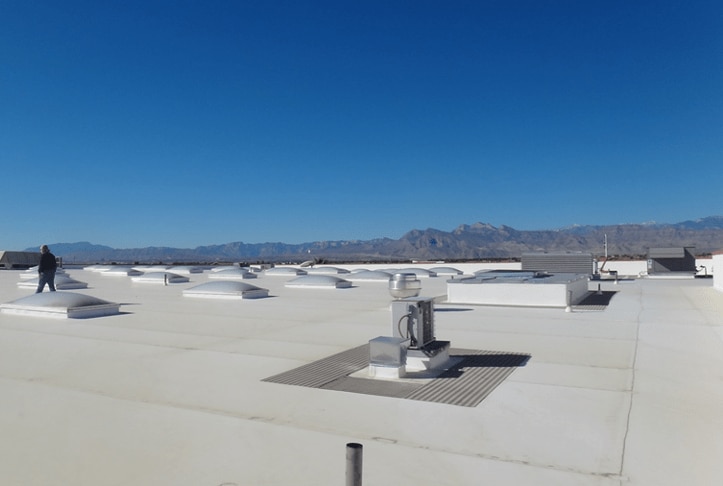Lanzada como membrana para techos en la década de 1960 y comercializada por primera vez en EE. UU. como membrana para techos comerciales a principios de la década de 1990, la poliolefina termoplástica (TPO) ha experimentado un crecimiento acelerado en los últimos veinte años, convirtiéndose en la membrana para techos comerciales de mayor expansión en el mercado. La TPO ahora representa casi el 50 por ciento de los techos de pendiente baja instalados en Estados Unidos.
Analizada exhaustivamente en laboratorios y bajo condiciones de envejecimiento acelerado, la TPO ha demostrado un buen desempeño frente al envejecimiento por calor, así como estabilidad frente a los rayos UV. Sin embargo, en parte debido a que el mercado de TPO ha experimentado la mayor parte de su crecimiento en los últimos 20 años, ha sido difícil evaluar adecuadamente el desempeño histórico de la TPO en el campo.
Hasta ahora.
Hoy en día, muchos techos de TPO en Estados Unidos han estado en servicio por más de 20 años. Para evaluar el desempeño y la capacidad de reparar las membranas de TPO para techo envejecidas, GAF adquirió muestras de 20 techos envejecidos ubicados en diversas partes del país, instalados sobre edificios de oficinas, instalaciones de manufactura, tiendas minoristas, bibliotecas, talleres de reparación de automóviles, almacenes y un supermercado. Estas 20 muestras marcan el comienzo de un estudio en curso, con la recolección de más muestras por realizar.
Se analizaron estas muestras centrando la atención en los modos de falla conocidos, como la erosión de la capa superior (grosor sobre el refuerzo) hasta el refuerzo y las fisuras en la superficie, además de las dudas sobre la posibilidad de reparar las membranas de TPO con el paso del tiempo.
Un equipo de GAF, que incluye a la directora de Ciencia de la Construcción y Techado, Jennifer Keegan, AAIA, y al arquitecto de Ciencia de la Construcción y Techado, Jim Kirby, AIA, presentó los resultados de estos hallazgos en el estudio "Desempeño comprobado: estudio de campo de TPO envejecida", preparado para la convención 2020 del IIBEC. El estudio y el informe son solo el inicio de un esfuerzo continuo por parte de GAF para evaluar el desempeño y la capacidad de reparación de las membranas de TPO envejecidas.
Resumen del estudio
Para obtener detalles exhaustivos, la metodología y los hallazgos del estudio de desempeño comprobado, recomendamos a los lectores descargar el informe completo. Lo siguiente es un resumen de alto nivel:
Selección de muestras:
- Las muestras de membranas fueron tomadas de techos de todo Estados Unidos que habían estado en servicio durante al menos 12 años y podían ofrecer una visión general del rendimiento típico en diversas ubicaciones. El acceso y la disponibilidad del propietario fueron un factor determinante.
- La muestra más antigua revisada hasta la fecha fue instalada en 2001.
- Todas las muestras fueron del mismo fabricante y en su mayoría fueron membranas lisas de 45 y 60 mil. Todas las muestras se tomaron de techos fijados mecánicamente, soldaduras por inducción y techos adheridos (es decir, no se tomaron muestras autoadherentes).
- Cuando fue posible, se tomaron dos muestras de cada techo. Cada una tenía un tamaño de 2 pies por 3 pies y abarcaba una unión soldada en el campo.
- Las muestras grandes se cortaron en piezas más pequeñas para evaluar el grosor de la membrana, el grosor sobre la malla, la fragilidad, el envejecimiento por calor y la resistencia al clima, la adherencia de las capas de las soldaduras existentes y la adherencia de las capas de las soldaduras de reparación.
Programa de pruebas y resumen de resultados
El programa de pruebas se basó en la norma ASTM D6878-19, con modificaciones según fuera necesario para muestras envejecidas. Las pruebas de envejecimiento artificial fueron reemplazadas por envejecimiento en el campo durante un mínimo de 12 años. Todas las pruebas se realizaron en un laboratorio comercial, y todos los datos recopilados se utilizaron en el análisis.
En general, los techos de membrana de TPO envejecidos en este estudio están funcionando bien y, en la mayoría de los casos, cumplen con los requisitos actuales de la norma ASTM D6878-19 para membranas recién fabricadas.
- Incluso después de 12 o más años de envejecimiento, tanto las muestras de membranas de 45 mil como de 60 mil superaron los requisitos de grosor actuales para membranas de TPO recién fabricadas.
- Tanto las membranas de 45 mil como 60 mil analizadas en este estudio siguen cumpliendo con estos requisitos de membranas recién fabricadas, con el grosor sobre la malla promediando más del 40 por ciento del grosor real de la membrana envejecida.
- Ninguna de las muestras, tanto las membranas de 45 mil como las de 60 mil, mostró signos de agrietamiento cuando se doblaron sobre el mandril y se observaron a una magnificación de 7X.
- Todas las muestras de 60 mil probadas hasta la fecha siguen cumpliendo con los requisitos de flexibilidad a bajas temperaturas después de 12 o más años de envejecimiento. Las muestras de 45 mil mostraron signos de agrietamiento a -40 °F. Aunque este sigue siendo un buen desempeño y no se puede esperar que las membranas envejecidas funcionen al mismo nivel que las nuevas, los datos respaldan el uso de membranas más gruesas para un rendimiento a largo plazo.
- Los valores de adherencia de capas de la membrana de TPO envejecida fueron un 15 por ciento más altos que el valor promedio de adherencia de capas del estudio de SRI sobre membranas de TPO nuevas. Como era de esperar, las soldaduras envejecidas parecen estar funcionando bien y son de una resistencia adecuada.
- Los valores de adherencia de las capas de la membrana de reparación nueva sobre la membrana de TPO envejecida son superiores al valor promedio de adherencia de capas de las membranas de TPO nuevas. Esto otorga cierta validez a la integridad de las reparaciones ejecutadas correctamente sobre membranas de TPO envejecidas.
Descargar el estudio Desempeño comprobado: estudio de campo de TPO envejecida: gaf.com/tpostudy

